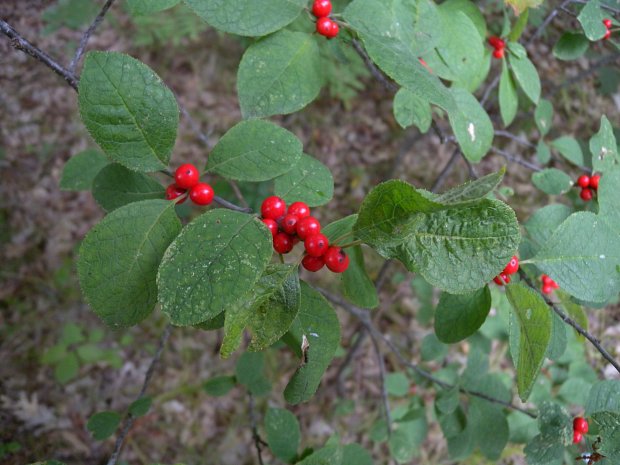Description: This shrub is 5-20' tall and sparingly to abundantly branched. The bark of twigs and young branches is gray or grayish brown and smooth, becoming covered with scattered white lenticels on older branches and the trunk. Deciduous alternate leaves occur along first-year shoots; these shoots are olive green, terete, and usually glabrous. The leaf blades are up to 3" long and 1" across; they are elliptic to ovate and shallowly serrated along their margins. The upper blade surfaces are medium to dark green and hairless, while their lower surfaces are pale green and slightly pubescent along the major veins. The slender petioles are up to ½" long and hairless to slightly pubescent.

Flowers are produced in small clusters from the axils of the leaves; individual flowers are about ¼" across. Winterberry is usually dioecious, producing shrubs with all male (staminate) flowers or shrubs with all female (pistillate) flowers. However, sometimes bisexual (perfect) flowers are produced with the unisexual flowers. Male flowers are produced in small clusters of 3-10 on short slender pedicels. Each male flower consists of a tiny calyx with 4-6 ciliate teeth, a corolla with 4-6 spreading petals that are joined together at the base, and 4-6 stamens. Individual petals are white to greenish white and oblong in shape. The female flowers occur in nearly sessile clusters of 1-3. The female flowers are similar to the male flowers, except they tend to have more petals (6-8) and there is a central ovary with sessile stigmata at its apex. Aberrant flowers with either fewer or more petals sometimes occur. The blooming period occurs from late spring to early summer. Each fertile female flower is replaced by a globoid berry about ¼" across that becomes bright red at maturity. Individual berries contain 1-2 smooth bony seeds that are ovoid-oblongoid in shape. Vegetative offshoots are not produced by the woody root system. The leaves turn black when exposed to frost during the fall.
Cultivation: The preference is partial sun, wet to moist conditions, and an acidic soil that is sandy or peaty. Significant problems with disease organisms and insect pests are rarely encountered. Temporary flooding is tolerated. Both male and female shrubs should be planted to encourage fruit set.
Range & Habitat: The native Winterberry is occasional in northern Illinois, but uncommon to absent elsewhere in the state. Habitats include bottomland woodlands, damp woodland borders, sandy flatwoods, soggy thickets, swamps, forested bogs and shrub bogs, and rocky banks of rivers. This shrub is found in both sandy and non-sandy woodlands, swamps, and thickets.
Faunal Associations: The flowers are cross-pollinated by small bees, various beetles, skippers, and possibly small butterflies (Krombein et al., 1979; Wilhelm & Rericha, 2017). The Andrenine bees, Andrena tridens and Andrena virginiana, are two such floral visitors of Winterberry. Insects that feed on the leaves of this shrub include larvae of a moth, Harrisimemna trisignata (Harris' Three-Spot), larvae of a small fly, Phytomyza verticillatae (Winterberry Leafminer), and an aphid, Macrosiphum ptericolens (hollies are used as winter hosts). The berries are eaten by various birds, including the Cedar Waxwing, Gray Catbird, Brown Thrasher, Veery, Hermit Thrush, and Bobwhite Quail (see Bird Table). Because these berries persist in good condition through the winter, they are particularly important as a source of emergency food some birds during the winter. As a result, the seeds of Winterberry are distributed to new areas by these berry-eating birds. The White-Footed Mouse and Deer Mouse also eat the berries and probably the seeds, while the Cottontail Rabbit has been known to gnaw on the bark of this shrub (Hamilton, 1941; Martin et al., 1951/1961).
Photographic Location: Edge of a moist sandy woodland at the Iroquois County Conservation Area in Illinois.
Comments: Winterberry is most attractive during the fall and winter because of its persistent berries. It is cultivated as a landscape plant and there are many cultivars available. Another shrubby Holly species with deciduous leaves is Ilex decidua (Possumhaw), which is found primarily in southern Illinois. Possumhaw is similar in appearance to Winterberry, but its differs from the latter shrub by the following characteristics: 1) it has leaves with crenate margins, rather than serrate, 2) its calyx teeth are glabrous rather than ciliate, 3) its flowers tend to have fewer petals, typically only four or five, and 4) its seeds are grooved, rather than smooth.